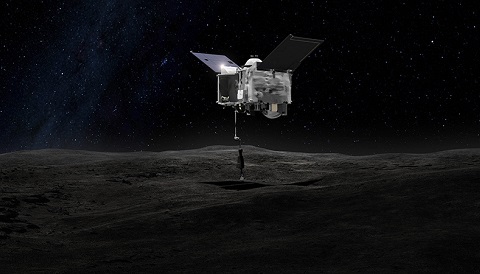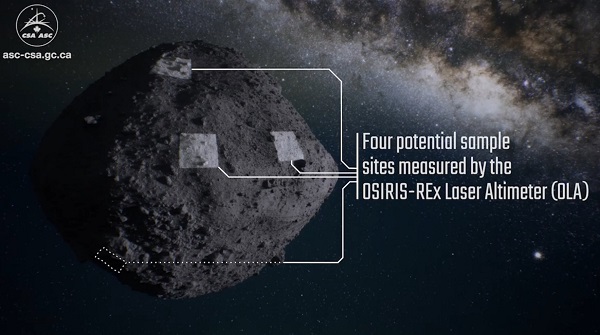NASA has picked the "Nightingale" site, located within a small crater on the asteroid Bennu, for its Osiris-REX mission to sample next year.

NASA / GSFC
And then there was one: NASA has announced the planned site on asteroid 101955 Bennu for next year’s touch-and-go sampling maneuver by the Origins, Spectral Interpretation, Resource Identification, Security, Regolith Explorer spacecraft, Osiris-REX.
After narrowing down the choice to four possible sites, each named after a bird native to Egypt, the team has selected the Nightingale site for next year's sampling maneuver and the Osprey site as a backup. The selected site minimizes risk to the spacecraft, while providing the best sampling opportunity.

NASA / GSFC / University of Arizona
"After thoroughly evaluating all four candidate sites, we made our final decision based on which site has the greatest amount of fine-grained material and how easily the spacecraft can access that material while keeping the spacecraft safe," says Dante Lauretta (University of Tucson) in a recent press release. "Of the four candidates, site Nightingale best meets these criteria."
Nightingale sits inside a 230-foot (70-meter) wide crater situated in the northern region of Bennu. The site appears relatively smooth, is subject to a lower level of sunlight and therefore lower temperatures, and should contain relatively pristine material.
The area isn't without its risks, though. The mission called for a sample site 50 meters (164 feet) wide until researchers got a good look at Bennu's rough surface. The sampling area at the Nightingale site is only 16 meters wide, meaning that Osiris-REX's touchdown will have to be nearly spot on. There's a boulder the size of a 2- to 3-story building on the nearby crater rim as well, something Osiris-REX will have to avoid as it backs away.

NASA / GSFC / University of Arizona
The selection comes after careful analysis and reconnaissance of four candidate sites named Osprey, Sandpiper, Kingfisher and Nightingale. The bird names are in keeping with an Egyptian theme: The Osiris in the spacecraft's name is a reference to the Egyptian god of the underworld, and Bennu was named after the bird of rebirth in Egyptian mythology.
A Daring Rescue
Scouting out the sites carried its own risks. Earlier this week, NASA revealed that it had nearly scrubbed the site reconnaissance timeline when the Madrid station of the Deep Space Network (DSN), which NASA uses to communicate with its spacecraft, suddenly stopped working.
The dropout on October 11th meant the team would have to skip the spacecraft's planned October 12th pass over the Osprey site, pushing the entire site-selection timeline back.
The Osiris-REX mission relies on optical navigation, in which the team examines images from the spacecraft, identifies landmarks such as boulders and craters, and thereby gauges the spacecraft’s relative position in space, as well as its velocity. This is more technically known as stereo photoclinometry.
"Typically, a dropped DSN pass would not cause such a scramble, but the critical nature of the images made us realize we needed to take action immediately," says Brennen Miller (Lockheed Martin).

CSA / ASC
Engineers compensated for abbreviated communication time by compressing the navigation update from 24 hours, which they typically call a “late update,” into just four hours, re-dubbed a “super late update.” To accomplish this, each team member had to be ready to immediately execute their part of the plan, like relay runners.
"We were pretty nervous about compressing the 24-hour timeline,” says Richard Burns, (NASA Goddard). “But the team was well practiced at performing late updates, so we knew we had the right people and the right tools to make it happen.” And happen it did — the images of the Osprey site came in crisp and centered.
In January 2020, Osiris-REX will begin a set of even closer imaging passes to further investigate the Nightingale and Osprey sites.
Capturing and returning a sample of Bennu to Earth for analysis is the highlight of the Osiris-REX mission, as the bits of rock and dust represent a pristine sample of the primordial solar system. Ancient asteroids are also thought to have played a key role in delivering compounds that led to the formation of life on the Earth. The touch-and-go maneuver is set for August 2020.
To carry out the sampling maneuver, Osiris-REX will use its Touch and Go Sample Acquisition Mechanism (TAGSAM), a drum-shaped container mounted on the end of a robotic arm. The arm will place the open end of the drum flat on the surface of the asteroid. It will then fire a burst of nitrogen at the surface to stir material upward and into the storage canister. TAGSAM has enough nitrogen gas for three sampling attempts if needed.
The Osiris-REX mission aims to collect 60 grams of asteroid material, about the mass of a C-alkaline battery. This will also represent the largest sample return from another world since the Apollo era.
After sampling, the arm will place the container with its precious cargo in the return capsule. Osiris-REX will depart Bennu in March 2021 and is set to re-enter Earth's atmosphere over the Utah Test and Training Range on September 24, 2023.
The stage is now set for a climactic sampling of the Nightingale site on Bennu in 2020.
 0
0









Comments
You must be logged in to post a comment.